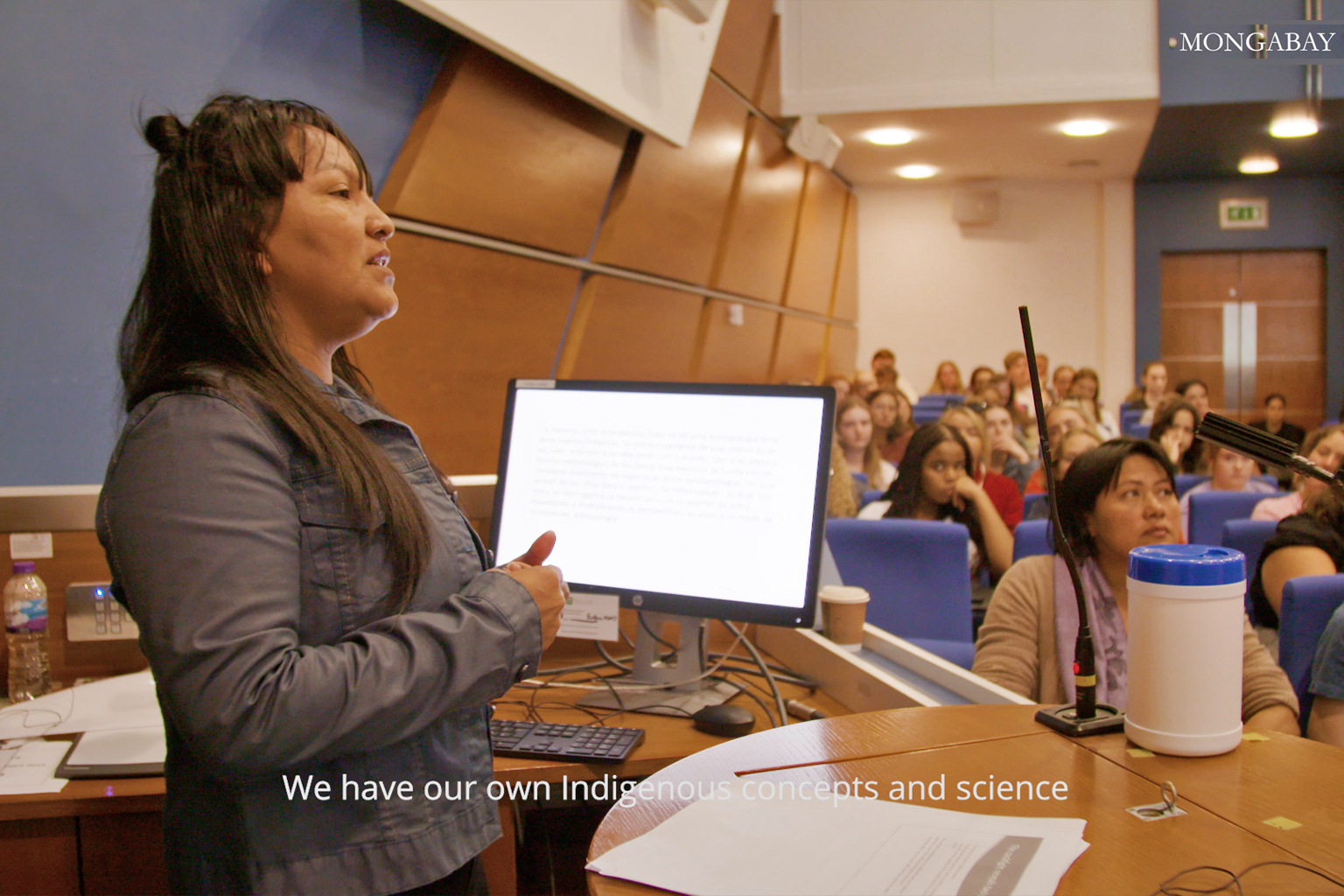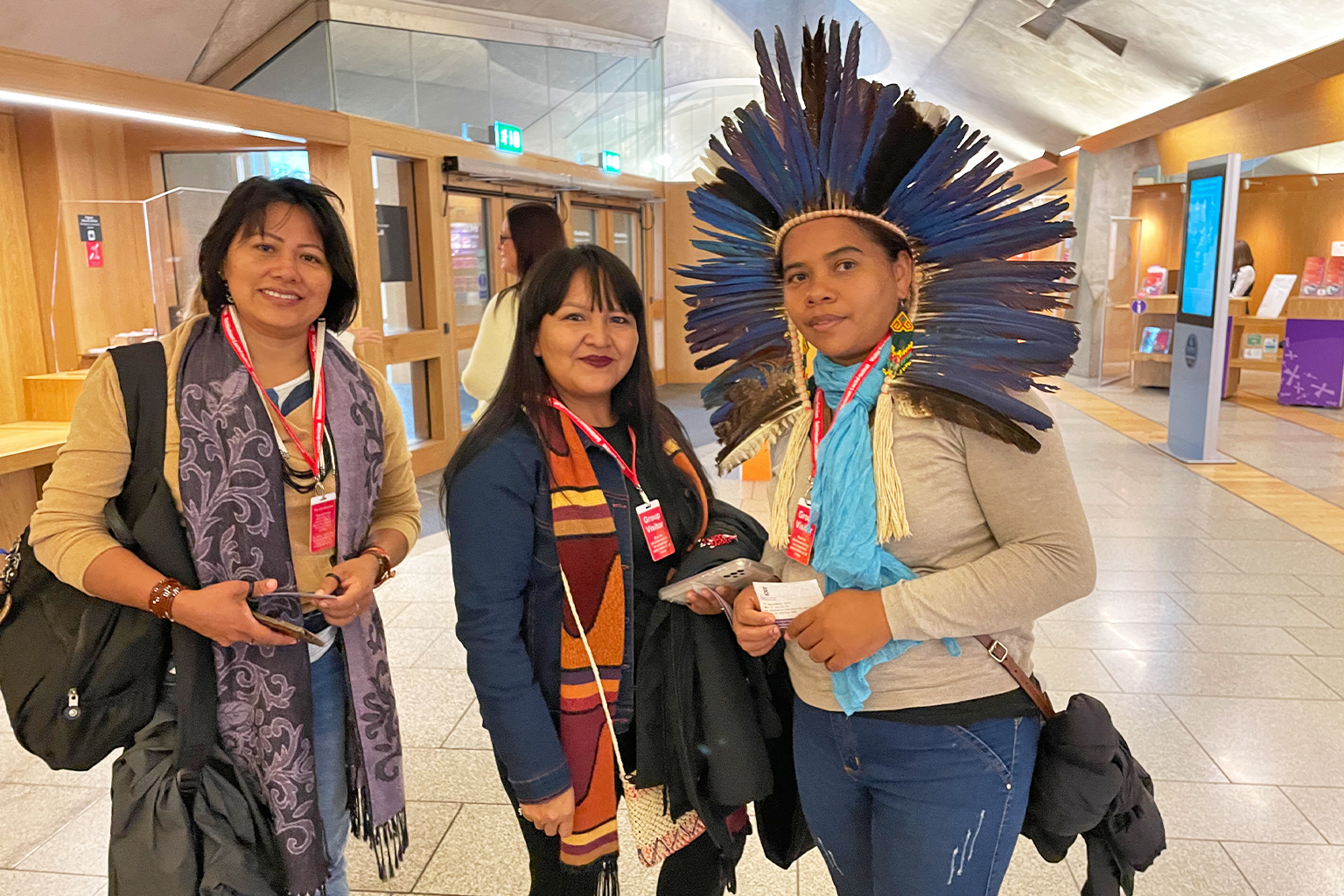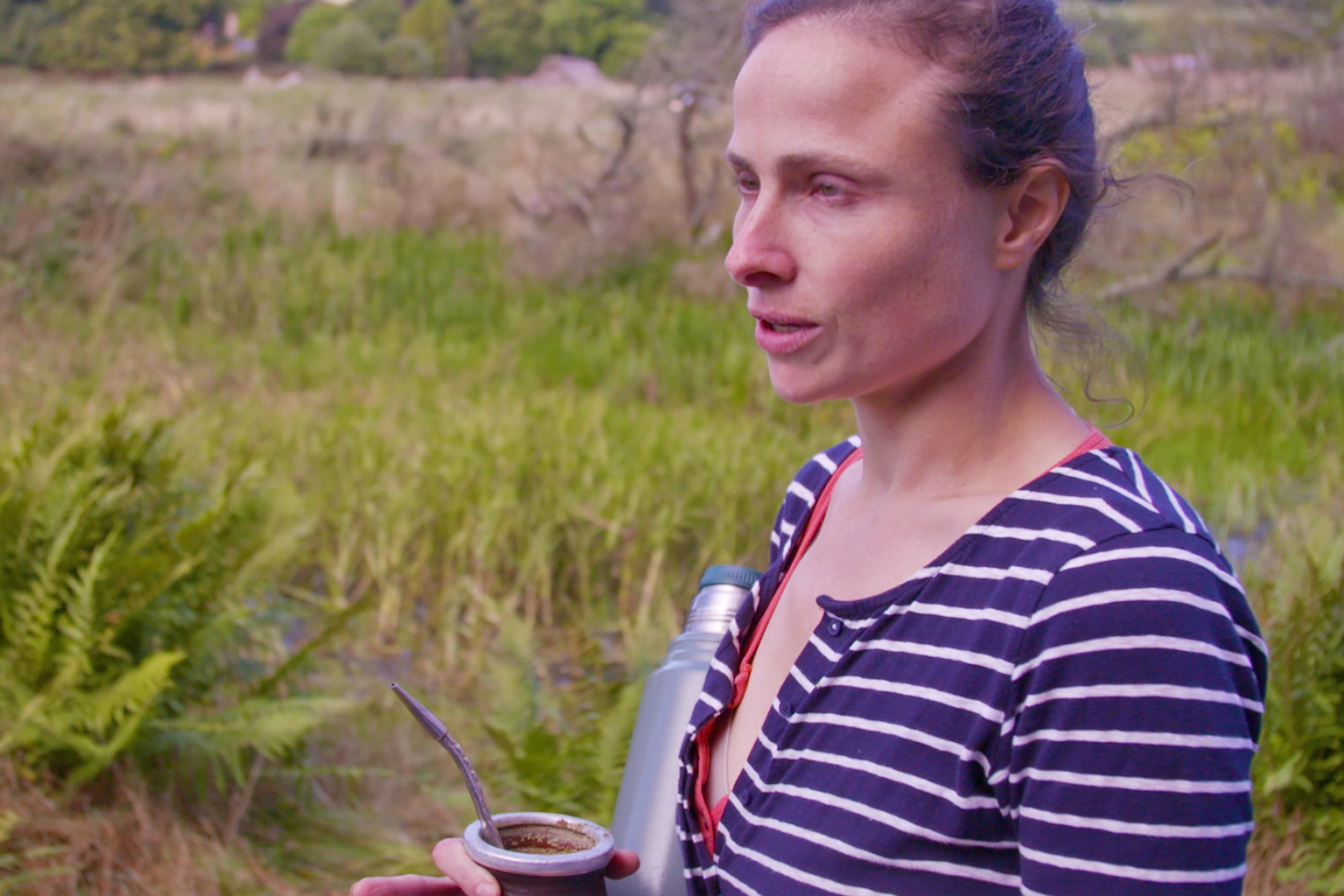- Three Indigenous women leaders who are also artists and anthropologists are reshaping the relationship between the peoples anthropologists study and those who do the studying.
- A meeting with the leader of the Scottish Green Party provided an opportunity to understand the connections between Scotland’s highland clearances of the 18th and 19th centuries and the land struggles faced by Brazil’s Indigenous peoples today.
- Bamff Wildland, a Scottish rewilding project, shows that as Brazil continues to be deforested, attempts are underway across the UK and Europe to reforest, increasing biodiversity and the land’s ability to capture carbon.
- These women leaders assert that Indigenous voices need to be heard and Indigenous relationships with nonhumans need to be understood and respected, if humanity is to turn the tide on climate change and biodiversity loss.
ST ANDREWS, Scotland — Francineia Fontes Baniwa laughs enthusiastically as she tells of a conversation she had with her traveling companion, Nelly Marubo while on the train to Scotland: “Nelly looked at me and said, ‘One day we are also going to be university professors!’ And I said, ‘for sure.’”
Nelly and Fran are examples of an emerging generation of Brazilian Indigenous anthropologists who are turning the tables on the traditional relationship between anthropologists and the peoples they study. Both are PhD candidates and visited the UK in September 2022, along with Glicéria Tupinambá, an Indigenous activist and artist.
The purpose of the trip? It was precisely to lecture at St Andrews, one of the UK’s top universities. Here, Glicéria lectured to first-year anthropology students about the Tupinambá’s land struggle, while Fran’s and Nelly’s lectures advocated the advantages of themselves as graduating Amazonian women anthropologists.
Nelly talks to the gathered faculty of anthropology about growing up in the forests. She remembers her mother telling her, “Anthropologists write everything wrong. You have to go there and write from our voice [because] anthropologists talk about us in their way, not in our way.”
And it was exactly what the three Indigenous women went to Scotland for.

While they come from very different regions of Brazil, all three women share the experience of struggling with their peoples for their Indigenous lands. Their stories paint a picture of a deeply racist country with an anti-Indigenous police force, judiciary and rural populations.
Fran’s Baniwa people are located in the northwestern Brazilian Amazon in the Alto Rio Negro region, near the border with Venezuela and Colombia. In the 1960s and ‘70s, gold mining exploded in the area. However, the 23 Indigenous groups of the Alto Rio Negro recognized the danger of mercury pollution and joined to form the Federation of Indigenous Organisations of the Negro River (FOIRN). “If they hadn’t acted, I think that the Alto Rio Negro wouldn’t exist today,” says Fran. “[We are] 23 peoples and we are very united in the question of the defence of the territory because we see what other [Indigenous] relatives go through. … Their territory being invaded, being polluted.”
Glicéria’s Tupinambá people are from the Atlantic Forest on Brazil’s coast in northeastern Bahia state. She recalls when their struggle against ranchers backed by police forces began in the 1990s, when she was a kid. “I walked in the woods, I fished […] and I climbed trees, I picked fruits. And one day I was in this routine I found a fence and this fence prevented me from reaching the river,” Glicéria says. “And from that day on we stayed in some very tight areas, very small.”

After 2001, Glicéria says she and some fellow young Tupinambá activists decided to fight back, bringing them into direct confrontation with the Federal Police. Glicéria says it was a desperate time during which she was arrested and imprisoned with her baby. After a prolonged and at times violent struggle, she says, the Tupinambá eventually got help from Brazilian academics. “They managed to record many things that were actually a violation of our rights and a criminalization of our leadership,” says Glicéria. The Tupinambá are now seeing their forests recover and the animals return to the lands, and Glicéria says that, through their struggle, they have managed to establish an important principle: “There is another way of life. May we have this right to live our way of life, connected to the land.”
Nelly is from the Javari Valley in the western Amazon near the border with northern Peru, where she says a 2010 aerial mapping survey revealed that 27 uncontacted Indigenous groups are living there alongside the Marubo people. This is the area where British Journalist Dom Phillips and Indigenous expert Bruno Pereira were murdered while reporting on illegal fishing in June 2022. According to Nelly, illegal fishing is just one of the many pressures pushing in on this culturally and biologically precious area. “We are living [though] an invasion on the Acre side with the hunters and from the Peruvian side with the miners and the coca planters. On the side of Amazonas, we [face] an invasion of fishermen who fish for the Colombians.”
The trip to Scotland, which was part of the program “Amplifying Amerindian Voices,” sponsored by the University of St Andrews Impact Fund, was organized by Cecilia McCallum, professor of anthropology at the Federal University of Bahia.
According to McCallum, the visit really added to the Scottish undergraduates’ understanding and experience. “They get to meet Amazonian Indigenous women who totally wipe out the kinds of stereotypes that it’s so hard to shake if you do study anthropology,” she says.

Colonization ties
In Scotland, the three Indigenous women met Scotland’s Green Party parliamentarians led by Patrick Harvie MSP. “We wanted to be political,” explains McCallum, “so we were really pleased when one of the lecturers at the University of St Andrews offered to organize a trip [for them] to see the [Scottish] Parliament.”
There, the three women outlined the struggles they faced and forged a new partnership. “I was very happy to have this meeting with them here, and that they were open to listen to us and understand and that we can join forces,” explains Glicéria.
Harvie identifies a link between historical Scottish issues relating to the highland clearances of the 18th and 19th centuries and Brazilian communities today struggling over land and deforestation. “Scotland is a country which in previous centuries saw massive de-forestation, seizure of land from the people who lived there, including by violence. And the inequality that arose from that is still with us centuries later,” says Harvie.
Fran says these similarities really struck her, from the burning of malocas (Indigenous longhouses) to colonizers forbidding Indigenous people to speak their language. “And here [in Scotland] there was also this. People arrived, killing, enslaving. Forcing them out of their territory … and this scar we [both] carry.”

For McCallum, giving these Indigenous Brazilian women the opportunity to hear the story of internal colonization within the UK was significant. “We have a long history of objectifying ‘Indians,’ Indigenous people, African [people]. … They [Indigenous people] also have got into the habit … of objectifying the colonial other and just seeing this great kind of mega-oppressor, which has white skin and blue eyes and so on, and it’s good to sophisticate a little bit their understanding of the history of colonialism.”
But while there was shared colonial trauma, there were also signs of hope during this trip — not least when Fran and Nelly were able to visit Bamff Wildlands, an ancient Scottish estate complete with a traditional baronial castle at its center. Current resident and custodian of Bamff, Sophie Ramsay, explains that the land has been in her family “for a ridiculously long time” — about 40 years — and her dad “was quite ecologically informed already” as he’d done a master’s in ecological conservation and “looked for ways that he could gradually make more space for nature and encourage natural processes.”
While deforestation has been ramping up at alarming rates in the Brazilian Amazon in the last four years under former President Jair Bolsonaro, in Europe, ancient woodlands were mostly wiped out centuries ago and today just 2.5% of the UK is covered in original native forest. But there is a growing movement to protect the woodlands that are left and to give over more land to native forest. Rewilding and regenerative farming are becoming more and more popular in the UK, with one publication even calling regenerative farming “the new rock ‘n’ roll.”
“More is required in response to the biodiversity crisis and climate change,” Ramsey explains, “and whilst people here talk a lot about the Amazon Rainforest, so much of our own nature has been destroyed historically that we are not even aware of what it might look like.” As her tour of the farm reveals, 450 acres of this Scottish estate have now been given over to an ambitious rewilding project that includes the reintroduction of beavers to help rewild a wetland drainage channel that runs across the estate.
“These are incredible initiatives” say Fran, “You get emotional here knowing that there are people who are in this same struggle, in this same cause with us.”

From “objects of study” to active voices
As Fran explained to a lecture theatre of around 300 first-year anthropologists, she brings a different perspective to the world of anthropology — which is the study of human culture and society: “We have a concept, a science of our own as Indigenous people to interpret narratives and understand the world through anthropology,” she says, adding that it changes “this issue of being the object of study, and today we are the protagonists of our own narratives, of our own history.”
Fran and Nelly see the development of an Indigenous anthropology as a critical tool in their toolbox to confront their ongoing land struggles. “In the middle of the forest, with all the challenges, and we are pioneers. I am the first woman with a master [degree] of my people,” says Fran, adding that she has the responsibility to represent 23 peoples as a protagonist “in this new and different world.”

Climate change is affecting all three Indigenous women’s communities, changing the normally predictable annual weather cycles and people’s traditional subsistence activities. “We monitor [the seasons] through star constellations. … Summertime, rainy season, dry season. Everything was perfect,” explains Fran. “Today, everything is mixed up, complicated. So it [climate change] directly affects our livelihood of preparing the field, fishing, harvesting.”
For these three women, universities and governments need to have a close dialogue with Indigenous peoples to find a solution to tackle climate change, as they are experts in their territories. For them, it is the connection that Indigenous knowledge has with other nonhuman beings — be they animals or spirits of the forests — that is important for Western culture to acknowledge and learn from.
The women’s experiences show it is possible to see the world differently and to create new and positive narratives, even in difficult times like those faced by the Tupinambá.
Recalling her mother’s advice, Nelly says, “Today, within the Indigenous movement, the Indigenist movement, we no longer want the white man to do things for us,” she explains to the gathered anthropology faculty.
Update (March 24, 2023): This article was updated to include the information that Scotland’s highland clearances were carried out during the 18th and 19th centuries.
Banner image: Glicéria Tupinambá watches First Minister’s Questions in the Scottish Parliament. Image by Max Baring for Mongabay.
FEEDBACK: Use this form to send a message to the author of this post. If you want to post a public comment, you can do that at the bottom of the page.
